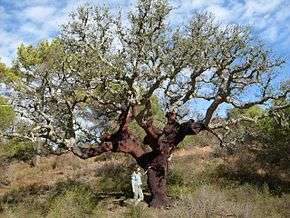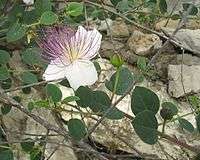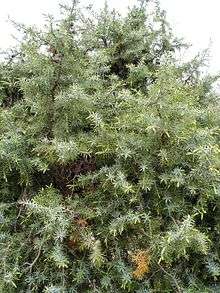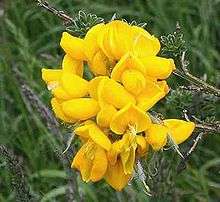Flora of Italy
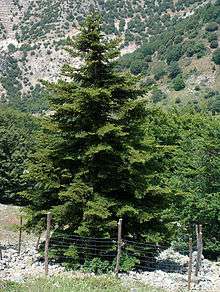
The flora of Italy was traditionally, estimated to comprise about 5,500 vascular plant species.[1] However, as of 2005, 6,759 species are recorded in the Data bank of Italian vascular flora.[2] Geobotanically, the Italian flora is shared between the Circumboreal Region and Mediterranean Region. According to the index compiled by the Italian Ministry for the Environment in 2001, 274 vascular plant species are protected.

Geography
Italy consists of a 1,000 km (620 miles) long peninsula extending out into the central Mediterranean, together with a number of islands to the South and West. The Apennines run north-south through the peninsula connecting the Alps in the North to Etna and the Peloritani mountains in Sicily in the South.The geology is diverse.
Northern Italy is dominated by the Alps and extensive valley of the Po river which is extensively agricultural and industrialised.
Central Italy includes the regions of Tuscany, Umbria, Marche and Lazio. It is dominated by the Apennines, from which a few major rivers flow. There are few natural plains. A process of land reclamation has replaced the coastal swamps and marshes with agricultural land.
Southern Italy includes the regions of Abruzzo, Molise, Apulia, Basilicata and Campania. Agriculture and industry are less developed.
The main islands are Sicily, Sardinia and the Aeolian Islands.
Each region has a distinct flora.
Ecoregions
An ecoregion is an ecologically and geographically defined area with characteristic natural communities and species. Different ecoregions are distinguished by different vegetation features.
In Italy Carlo Blasi et al. identify and map 2 Divisions (Temperate and Mediterranean), 13 Provinces, 33 Sections and approximately 80 Subsections. Each unit has an alphanumeric code that indicates its hierarchical level and a full name that indicates its geographic location and main diagnostic factor.[3]
The Temperate Division includes the Alps, the Po Plain, and most of the Apennines. It accounts for 64% of Italy. This area is characterized by almost absent summer aridity and by a marked differences between summer and winter temperatures. The natural vegetation mainly consist of forests, with broad-leaved deciduous plants (Quercus, Fagus and Carpinus species).
The Mediterranean Division includes the southern Apennines, the Tyrrhenian and Ionian coasts, the southern Adriatic coast and the Islands. It accounts almost 36% of the Italian territory. This area is characterized by summer aridity, with precipitations concentrated in autumn and winter. The natural vegetation mainly consists of mixed woods of evergreen and deciduous species, shrublands and Mediterranean maquis.
The floral composition
The native vegetation of Italy reflects the diversity of the physical environment: the differences in geology, the differences of altitude above sea level and the diversity of the climate between the continental and the peninsular Italy, that give rise to various phytoclimatic areas.
The peninsula and islands are dominated by the characteristics of the Mediterranean climate, with mild and rainy winters and very warm and dry summers. On the contrary in the northern of Italy you have lower temperatures in winter and a more uniform distribution of rainfall during the summer time.
The species of plants present in Italy belong to the flora of the continental Europe or to the Mediterranean flora. We can distinguish in some cases Western species (e.g. the hornbeam, limited to Western Europe) and eastern species (e.g. the oriental hornbeam, present in Eastern Europe).
The last Ice Age, the Würm Glaciation, in the Alps ended about 12,000 years ago and you can still recognize its influence on vegetation, in particular by means of the glacial relicts (relict species). A well known example is the Etna birch (Betula aetniensis), driven in Sicily at a time when the climate was much colder.
Broadly there are three different vegetational zones of forests or bushes in Italy:
1. evergreen vegetation: maquis shrubland (Italian: macchia mediterranea) with densely growing plants and shrubs that always have leaves on. This flora is typical of the dry mediterranean climate, especially along the coast and in the islands.
The most common plants are olives (Olea europaea), agrumes (Citrus species), maritime pines (Pinus pinaster), cork oaks (Quercus suber), holm oak, carrubo (Ceratonia siliqua), myrtles (Myrtus communis), strawberry tree (Arbutus unedo), sage, junipers (Juniperus communis, tree heath and bay laurel (Laurus nobilis).(Mediterranean South)
2. broad-leaved vegetation (oaks, beeches, chestnuts): it is typical of the mountain region with a humid climate (Apennines and Prealps). Temperate.
The most common plants are Castanea sativa, Fagus sylvatica, the relicts Pinus mugo and Pinus nigra var. italica, Sorbus chamaemespilus, Arctostaphylos uva-ursi, and Vaccinium vitis-idaea. There are also a high number of endemic species increasing at higher elevations. Alpine species include Gentiana nivalis, Androsace alpina, Polygala chamaebuxus, Saxifraga oppositifolia and Carlina acaulis.
3. coniferous vegetation (larches, pines, firs): it is an evergreen vegetation typical of the Alps and of a few high Apennines areas. Temperate.
The most common plants present in this phytoclimatic area are Picea abies, Abies alba, Larix decidua, Pinus sylvestris, Pinus nigra, Pinus cembra and Pinus mugo.
In the Po Basin you can found mixed forests that include mixed deciduous oak/hornbeam forests (Quercus robur, Quercus cerris, Carpinus betulus, Ulmus minor, Fraxinus ornus) and Riparian forest, as well as flood-plain vegetation of the Po Basin (Fraxinus oxycarpa, Salix alba, Alnus glutinosa, Ulmus minor, Populus alba, Populus nigra, Quercus robur).
There are also plant associations almost treeless: grasslands, pastures, deserts. In the mountains, gradually, the forest turns in mountain pastures, scattered in various shrubs (e.g. pinus mugo, rhododendrons, junipers) and dotted with small colorful flowers. Higher up, you reach the montane grasslands and even areas similar to a desert because they have no or almost no vegetation (rocks, Glaciers).
Species richness in Southern Europe
Italy has around 6,711 (6,759) species of vascular plants (Conti et al., 2005 An inventory of vascular plants endemic to Italy), preceded only by the Iberian Peninsula and Balearic Islands with around 7,500 vascular plant taxa (species and subspecies) (Castroviejo 2010 Flora Iberica), followed by Italy with 6,711 (6,759) species (Conti et al., 2005 An inventory of vascular plants endemic to Italy). In Greece, the number of species is around 5,700 (Strid and Tan, 1997 Flora Hellenica) and in France, there are 4,630 species (Walter and Gillett, 1998 1997 IUCN red list of threatened plants). Per unit area Greece is the country with the highest concentration of native plant species.
Endemic species
Italy has 1371 endemic species and subspecies (18.9% of the total vascular flora).[4]
Threats
Habitat loss, fragmentation and degradation are the most significant threats to plant species that occur in Italy. Also changing water flow patterns and over-extraction, increasing droughts due to climate change, pollution and the introduction of alien species threaten the flora. Other threats come from farming (as a result of agricultural expansion and intensification), urbanization and tourism.[5]
The cultivation of plants that give textile fibers (Cannabis sativa, Linum usitatissimum), the cultivation of sugar beet (Beta vulgaris), cereals, potatoes, orchards, vineyards and olive groves have almost replaced the natural vegetation.
The action of man since Roman times has resulted in the destruction of most of the lowland forests and hills, in the expansion of pastures, in the extinction of many species and in the introduction of exotic species which are then naturalized. For example, the Indian fig opuntia (Opuntia ficus-indica), is now so common in the warmer parts of the Southern Italy. Also the invasive false Acacia (Robinia) is widely spread.
Conservation
Italy is a signatory to the Berne Convention on the Conservation of European Wildlife and Natural Habitats and the Habitats Directive both affording protection to the fauna and flora of Italy.
Plants and shrubs of the Italian macchia mediterranea
Notable floras
- Arcangeli, Giovanni. Compendio della flora italiana. Torino: Loescher, 1882.
- Cesati, Vincenzo de, Giovanni Passerini & Giuseppe Gibelli. Compendio della flora italiana. Vol. 1-35. Milano: Vallardi, 1868-1886.
- Fiori, Adriano. Nuova flora analitica d'Italia. Vol. 1-2. Firenze: Ricci, 1923-1929.
- Parlatore, Filippo & Teodoro Caruel. Flora italiana. Vol. 1-10. Firenze: Le Monnier, 1848-1896.
- Pignatti, Sandro. Flora d'Italia. Vol. 1-3. Bologna: Edagricole, 1982. ISBN 88-506-2449-2.
Herbaria
See List of herbaria in Europe.
Database
The Department of Biology of the University of Trieste houses the National Data Bank for the Italian Flora and Vegetation.
See also
- Geography of Italy
- List of national parks of Italy
- Flora of the Alps
- High Alps
- Po Basin mixed forests
- Illyrian deciduous forests
- Italian sclerophyllous and semi-deciduous forests
- Apennine deciduous montane forest
- South Apennine mixed montane forests
- Tyrrhenian-Adriatic sclerophyllous and mixed forests
- Dinaric Mountains mixed forests
- Orchidee del Gargano
- List of orchids of Italy In Italian Links in turn to Orchidee della Montagna della Ganzaria, Orchidee di Monte Pellegrino, Orchidee dello Zingaro and Orchidee di Cavagrande del Cassibile.
- Specie botaniche in Italia
- Specie botaniche in Sardegna
References
- ↑ Pignatti,S.,1982 Flora d’Italia. Edagricole, Bologna, vol. 1-3, 1982
- ↑ Riccardo Guarino, Sabina Addamiano, Marco La Rosa, Sandro Pignatti Flora Italiana Digitale:an interactive identification tool for the Flora of Italy
- ↑ Carlo Blasi, Giulia Capotorti, Daniela Smiraglia, Domenico Guida, Laura Zavattero, Barbara Mollo, Raffaella Frondoni, and Riccardo Copiz A thematic contribution to the National Biodiversity Strategy - The ecoregions of Italy
- ↑ Lorenzo Peruzzi. Fabio Conti and Fabrizio Bartolucci An inventory of vascular plants endemic to Italy
- ↑ Italy’s biodiversity at risk IUCN
Further reading
- Tutin T.G. et al., 1964-1980. Flora Europaea, Cambridge University Press
- Ansaldi M., Medda E., Plastino S., 1994. I fiori delle Apuane, Mauro Baroni & c. s.a.s., Viareggio
- D. Aeschimann; K. Lauber; D. Martin Moser; J. P. Theurillat. Flora Alpina. Bologna, Zanichelli, 2004. ISBN 88-08-07159-6
External links
| Wikimedia Commons has media related to Flora of Italy. |
- Acta Plantarum Checklist. Extensive photo gallery. Bibliography. Other features. Image access vis "Schede Botaniche" and "Galleria della Flora italiana"
- Ecoregions of Italy Sapienza
- Flora Italiana Digitale Distribution, images (via Google search), flowering time,altitude.
- Melanie Bilz, Shelagh P. Kell, Nigel Maxted and Richard V. Lansdown European Red List of Vascular Plants
- Walter and Gillett, 1998 1997 IUCN red list of threatened plants
- Natura Mediterraneo Forum. Many images (see Galleria Tassonomica) In Italian.
- Franz Xaver/Pflanzen aus Italien
